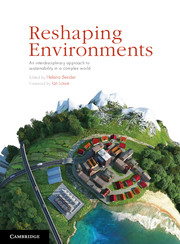Book contents
- Frontmatter
- Contents
- Contributors
- Acknowledgements
- Introduction Reshaping environments – an opportunity for envisioning the future
- Part 1 Cases
- 1 Costa Rica’s dry north-west
- 2 Reshaping land transport in Singapore
- 3 Evaluating different ways of managing forested landscapes
- 4 Changing the landscape management paradigm with farmers
- 5 Meeting development goals without blowing your carbon budget
- 6 The EGLE has landed
- 7 Reshaping the Murray-Darling Basin, Australia
- 8 Burning questions
- Part 2 Skills
- Part 3 Theory
- Index
- Plate Section
- References
8 - Burning questions
researching the meaning of fire in the Australian landscape
from Part 1 - Cases
Published online by Cambridge University Press: 05 February 2013
- Frontmatter
- Contents
- Contributors
- Acknowledgements
- Introduction Reshaping environments – an opportunity for envisioning the future
- Part 1 Cases
- 1 Costa Rica’s dry north-west
- 2 Reshaping land transport in Singapore
- 3 Evaluating different ways of managing forested landscapes
- 4 Changing the landscape management paradigm with farmers
- 5 Meeting development goals without blowing your carbon budget
- 6 The EGLE has landed
- 7 Reshaping the Murray-Darling Basin, Australia
- 8 Burning questions
- Part 2 Skills
- Part 3 Theory
- Index
- Plate Section
- References
Summary
Fire history describes, as few phenomena can, the interplay between humans and landscape, which is to say it illuminates the character of each. (Pyne 1990, p. 1133)
For me fire is part of a bigger narrative about learning to live like an Australian.
(Campbell 2003, p. 245)Introduction
In this chapter the idea of what fire and bushfires (called ‘wildfires’ in other places) mean in Australian society is examined in two ways: historically, as interpreted through literature, and through a visual analysis of two Australian colonial paintings. Fire has an important place within people’s interactions and relationships with the world around them. People have always used fire to shape and manipulate the natural environment. Yet people also fear fire as it can be a source of danger. In Australia, fire is something that features very powerfully in the popular imagination because it is associated in many Australian landscapes with uncontrolled bushfires.
Interestingly, the term ‘bushfire’ has a meaning that is specific to Australian society. According to the Australian Merriam-Webster dictionary online (2011), the term ‘bushfire’ refers to ‘an uncontrolled fire in a bush area’. In turn, the term ‘bush’ refers to ‘a largely uncleared or sparsely settled area (as in Australia) usually scrub covered or forested: wilderness …’. ‘Bushfire’ therefore literally refers to a fire that starts in a non-suburban setting – on areas commonly associated with nature conservation. However, there is a conflation of meanings in the common use of the term ‘bushfire’. As more and more housing is built in the area called the ‘peri-urban’ – on the edge of cities and close to the Australian bush – more and more people are moving to live next to these nature conservation areas. Consequently, these areas cannot always be described as ‘sparsely settled’. The expansion of these more heavily settled, bush areas has increased the number of people exposed to bushfire risk. This has, in turn, increased people’s expectations that fire authorities will take measures to protect people and their properties from bushfire. Furthermore, while ‘bushfire’ is the common terminology for fire associated with treed landscapes, grass fires are also common in the Australian landscape. In the Australian idiom, the term ‘bushfire’ has therefore become a catch-all phrase. It refers to a wildfire anywhere and to fires that turn out to be deliberately lit or the result of accidental occurrences such as machinery sparks, as well as fires that come from lightning strikes or combustion associated with prolonged hot weather conditions.
- Type
- Chapter
- Information
- Reshaping EnvironmentsAn Interdisciplinary Approach to Sustainability in a Complex World, pp. 187 - 206Publisher: Cambridge University PressPrint publication year: 2012



